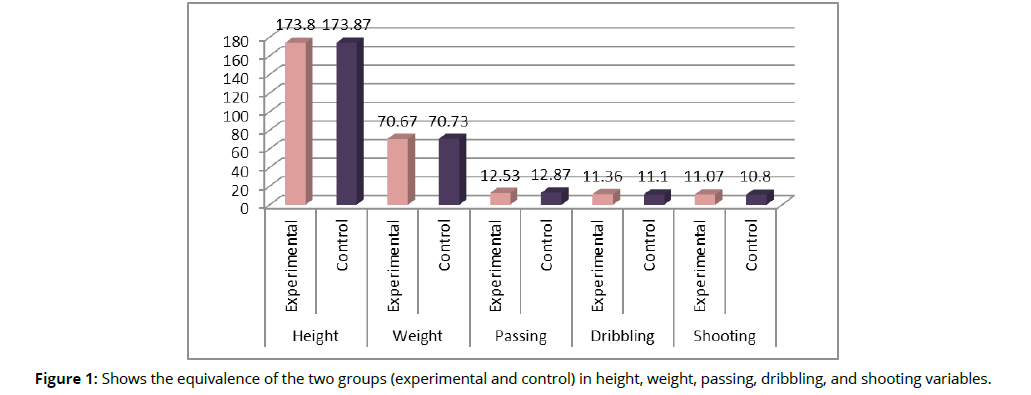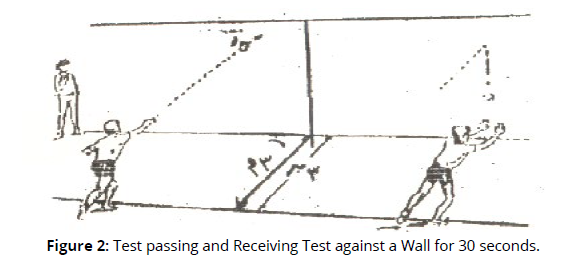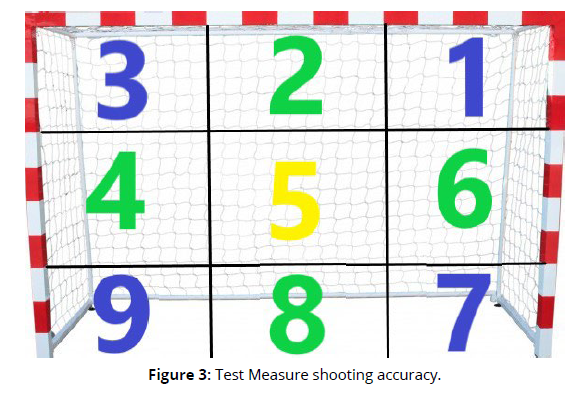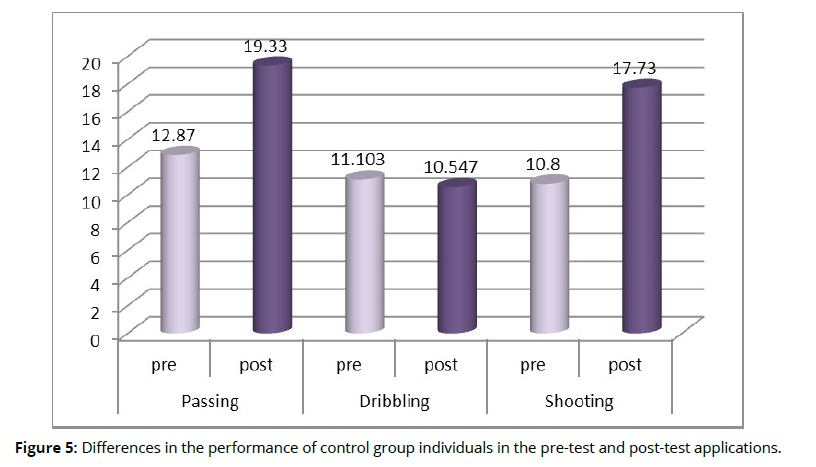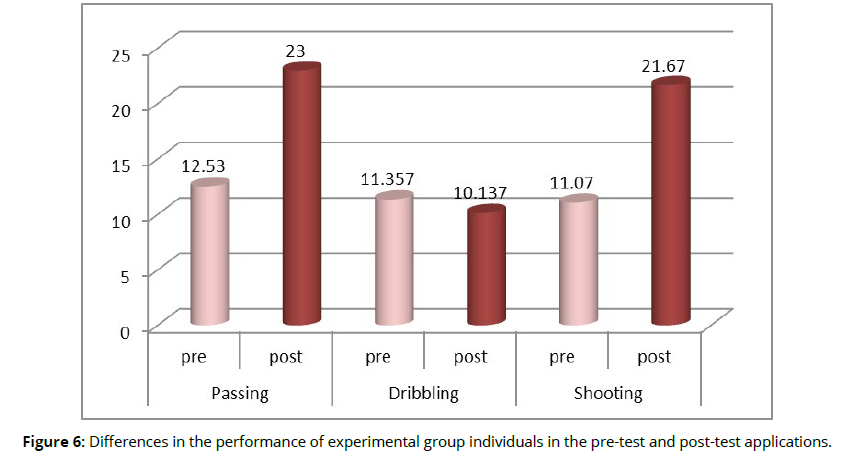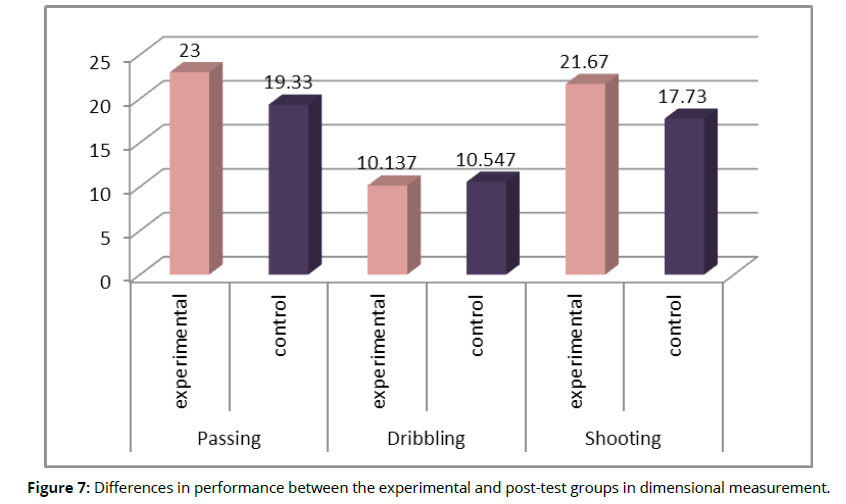Full Length Research Paper - (2023) Volume 18, Issue 3
*Correspondence: Maen Ahmad Mahmoud Shalan, Physical Education Department, Faculty of Sport Science, Mutah University, Jordan, Email:
Abstract
Objectives: This study aimed to investigate the impact of a mental imagery-based instructional program on learning basic handball skills.
Methodology: The study employed an experimental design with a pretest-posttest comparison between an experimental group and a control group. The study population consisted of 76 students enrolled in the Handball 1 course at the Faculty of Sports Sciences, Mu'tah University, during the second semester of 2021/2022. The sample included 30 randomly selected students, divided into two groups: an experimental group (n=15) that learned basic skills using the proposed instructional program with mental imagery for 8 weeks (two weekly sessions), and a control group (n=15) that learned basic skills using traditional methods for 8 weeks (two weekly sessions). Accuracy shooting test, passing and receiving against a wall for 30 seconds, and zigzag ball dribbling (15 meters) were used to collect data.
Results: The study found that the proposed program using mental imagery accompanied by learning technical performance had a positive effect on the development of basic handball skills (passing, dribbling, shooting). learning using mental imagery outperforms traditional learning in developing motor performance of basic skills in handball (passing, jumping, shooting).
Conclusion: The study recommended the use of mental imagery during instructional units as an effective approach for teaching basic handball skills. It also emphasized the use of mental imagery as a teaching method by physical education teachers in general and handball coaches in particular.
Keywords
Instructional program. Mental imagery. Dribbling. Passing. Shooting. Basic skills.
ABSTRACTO
Objetivos: Este estudio tuvo como objetivo investigar el impacto de un programa de instrucción basado en imágenes mentales en el aprendizaje de habilidades básicas de balonmano.
Metodología: El estudio empleó un diseño experimental con una comparación pretest-postest entre un grupo experimental y un grupo de control. La población de estudio estuvo conformada por 76 estudiantes matriculados en el curso de Handball 1 en la Facultad de Ciencias del Deporte, Universidad de Mu'tah, durante el segundo semestre de 2021/2022. La muestra estuvo compuesta por 30 estudiantes seleccionados al azar, divididos en dos grupos: un grupo experimental (n=15) que aprendieron habilidades básicas utilizando el programa instruccional propuesto con imágenes mentales durante 8 semanas (dos sesiones semanales), y un grupo control (n=15 ) que aprendieron habilidades básicas utilizando métodos tradicionales durante 8 semanas (dos sesiones semanales). Para la recolección de datos se utilizó la prueba de precisión de tiro, pase y recepción contra una pared durante 30 segundos y regate del balón en zigzag (15 metros).
Resultados: El estudio encontró que el programa propuesto que utiliza imágenes mentales acompañado del aprendizaje del rendimiento técnico tuvo un efecto positivo en el desarrollo de las habilidades básicas del balonmano (pases, regates, tiros). El aprendizaje utilizando imágenes mentales supera al aprendizaje tradicional en el desarrollo del rendimiento motor de las habilidades básicas del balonmano (pases, saltos, lanzamientos).
Conclusión: El estudio recomendó el uso de imágenes mentales durante las unidades de instrucción como un enfoque eficaz para la enseñanza de las habilidades básicas de balonmano. También hizo hincapié en el uso de imágenes mentales como método de enseñanza por parte de los profesores de educación física en general y de los entrenadores de balonmano en particular.
Palabras clave: Programa de instrucción. Imaginación mental. Regate. Pase. Tiro. Destrezas básicas.
ABSTRATO
Objetivos: Este estudo teve como objetivo investigar o impacto de um programa de instrução baseado em imagens mentais no aprendizado de habilidades básicas de handebol.
Metodologia: O estudo empregou um desenho experimental com uma comparação pré-teste-pós-teste entre um grupo experimental e um grupo controle. A população do estudo foi composta por 76 alunos matriculados no curso de Handebol 1 da Faculdade de Ciências do Esporte da Mu'tah University, durante o segundo semestre de 2021/2022. A amostra incluiu 30 alunos selecionados aleatoriamente, divididos em dois grupos: um grupo experimental (n=15) que aprendeu habilidades básicas usando o programa instrucional proposto com imagens mentais por 8 semanas (duas sessões semanais) e um grupo controle (n=15 ) que aprenderam habilidades básicas usando métodos tradicionais por 8 semanas (duas sessões semanais). Para a coleta de dados, foram utilizados testes de precisão de chute, passe e recepção contra a parede por 30 segundos e drible de bola em zigue-zague (15 metros).
Resultados: O estudo constatou que o programa proposto usando imagens mentais acompanhado de aprendizagem de desempenho técnico teve um efeito positivo no desenvolvimento de habilidades básicas do handebol (passe, drible, chute). aprender usando imagens mentais supera o aprendizado tradicional no desenvolvimento do desempenho motor de habilidades básicas no handebol (passe, salto, arremesso
Conclusão: O estudo recomendou o uso de imagens mentais durante as unidades instrucionais como uma abordagem eficaz para o ensino de habilidades básicas do handebol. Também enfatizou o uso da imaginação como método de ensino por professores de educação física em geral e treinadores de handebol em particular.
Palavras-chave: Programa instrucional. Imaginação. Drible. Passe. Chute. Habilidades básicas.
Introduction
In recent years, there has been an increased interest in the psychological aspects by experts in sports psychology, motor learning, researchers, and sports coaches due to their significance in contributing to the improvement of learning sports skills. Regardless of the athlete's high physical fitness and strong physical structure, the presence of guidance and leadership is essential for these physical abilities and fitness to be utilized effectively. This role is fulfilled by the mind, which enables the player and learner to harness these capabilities in the right direction that serves the achievement of their goals.
The mental imagery is considered one of the fundamental cognitive processes that help us in remembering, planning, navigating between past events, and making decisions. Mental imagery also plays an essential role in many higher-order thinking skills that educational systems worldwide aim to instill in their students. The concept of mental imagery refers to the process by which an individual forms images and scenarios that express their understanding and perception of the current situation, whether those images are visual, sensory, or emotional. Mental images represent the outcome of that process (Saaydeh et al., 2022).
Mental imagery has a close relationship with learning in general and motor learning specifically. It adds a cognitive aspect to performance by visualizing the complete performance and then recalling and rehearsing that image in its entirety or in parts. Training on mental imagery helps in correcting performance or increasing arousal for optimal performance, as correction during performance represents the cognitive aspect of mental imagery (Al-Jubouri & Noori, 2015). Mental imagery has two directions: one can be used in the educational process as a cognitive aspect, and the other can be used as a psychological facilitator for performance by envisioning it correctly, providing the desired arousal for performance (Khekhun, 2002).
Mental imagery is a cognitive process aimed at creating a mental representation of the overall performance and movement mechanics for training and repeated execution of the movement, ultimately leading to optimal performance. It reflects objects, phenomena, or events that the individual has perceived in their previous experiences, and it is not influenced by the present moment of visualization (Al- Swaidi, 2004).
Cpylshyn (2018) defines it as the ability to represent events and stimuli in the mind in the absence of sensory stimuli, in different situations, and manipulate and control them.
Eysenck (2018) views it as the process of mentally representing events, objects, and situations in a similar way to their real image, as they were presented to the individual during perception.
Mental imagery provides the ability to control and stabilize performance, leading to optimal performance and achievement. The learner's use of mental imagery skills improves motor skills, enhances attentional focus, prevents cognitive distractions, instills self-confidence, and increases the learner's ability to manage emotions that may hinder performance. It also helps prevent negative imagery that impairs performance by countering negative emotions such as anxiety and counteracting the detrimental effects of negative expectations, thus enhancing the chances of success (Weiss et al., 2017).
Al-Awai (2002) refers to mental imagery as a mental skill or cognitive performance through which the athlete's mind can be programmed to respond according to this programming. This skill is not limited to retrieving previous experiences but also works on creating and generating new experiences.
Mental imagery can be categorized into external mental imagery. Rattab (2007) states that external mental imagery relies on the athlete visualizing the performance of another person, such as an exceptional player, a sports champion, or watching a video. In this type, the mental image is evoked as it is, and visual perception plays a primary role.
The second type is internal mental imagery, as mentioned by Asmar and Mohammed (2011). This type relies on the athlete mentally evoking images of specific skills or events that they have previously acquired, witnessed, or learned. Typically, these mental images arise from within the individual and are not the result of observing external objects or events.
Sabir (2005) points out that one of the benefits of mental imagery is improving performance through mental rehearsal of the skill. This includes eliminating errors by visualizing the correct technique for artistic performance. Most individuals who have a clear understanding of the key aspects of skill execution can use mental imagery to compare their responses to optimal performance and then attempt to correct any incorrect responses.
Additionally, Khekhun (2002) emphasizes the importance of using mental imagery for performance enhancement, which involves eliminating errors by visualizing the correct technique for technical performance. Proper visualization of the motor skill results in neural-muscular responses similar to the mental responses. Thus, the process of imagery involves sending neural signals in the nervous system to the muscles to execute the desired skill.
Handball, like any ball game, has its own fundamental principles that are essential for mastering and elevating it to optimal levels of achievement. The proper approach to teaching, learning, and training methods is crucial for the success and progress of any handball team, as it largely depends on individuals' mastery of the basic principles of the game to reach the highest levels of performance.
Maawad (1994) argues that teaching the fundamental principles is considered the most challenging stage but is necessary for raising the level and progressing towards proficiency.
Furthermore, Darwish (2002) indicates that basic skills in handball are the cornerstone of learners' development, as they work on enhancing personal aspects and learning essential skills. Alongside acquiring knowledge and information, this is of great importance as it helps in teaching the basic skills in a holistic, balanced unit, encompassing physical, mental, psychological, and social aspects. This unit serves as the foundation of physical education curriculum, representing the integrated structure by providing comprehensive experiences.
Study Problem
The educational process in the field of sports relies on physical, skill-based, and mental training simultaneously. Therefore, mental visualization is considered an effective method that offers learners several advantages, including rapid mastery of motor skills and aesthetic performance.
Through observing most of the educational units taught in lectures for practical subjects in general, and specifically for handball courses, the researchers noticed a lack of sufficient emphasis on mental visualization during teaching basic skills. By reviewing previous literature and studies conducted in the Jordanian environment, such as the study by Rababah (2021), Qatamin (2020), Nawafleh (2021), and Shal'an (2022), all of these studies utilized different teaching strategies and methods, such as the Mustn methods and teaching methods that rely on modern technology. However, no study has employed mental processes in the educational programs. Therefore, this study aims to explore one of these mental processes (mental visualization) and its impact on learning basic skills in handball.
Study objectives
1. To investigate the impact of a proposed instructional program using mental imagery on learning the basic skills of handball (passing, dribbling, shooting).
2. To examine the effect of using traditional methods on learning the basic skills of handball (passing, dribbling, shooting).
3. To compare the differences in learning the basic skills of handball (passing, dribbling, shooting) between the control and the experimental group.
Study hypotheses
1. There are no statistically significant differences (α≤0.05) in learning the basic skills of handball (passing, dribbling, shooting) for the control group (conventional method) between pretest and posttest measurements.
2. There are no statistically significant differences (α≤0.05) in learning the basic skills of handball (passing, dribbling, shooting) for the experimental group (mental imagery) between pretest and posttest measurements.
3. There are no statistically significant differences (α≤0.05) in learning the basic skills of handball (passing, dribbling, shooting) between the experimental group (mental imagery) and the control group (traditional method) on the posttest measurement.
Methodology and Procedures
Study design
The study utilized an experimental design with a control group and an experimental group. The pretest and posttest measurements were compared within each group, and then the two groups were compared.
Study population
The study population consisted of 76 students enrolled in the Handball course (1) at the Faculty of Sports Sciences, Mu'tah University, based on the admission and registration records for the second semester of 2021/2022.
Study sample
The study sample was selected randomly and consisted of 30 students. The sample was divided into two groups:
Experimental group: It consisted of 15 students who learned the basic skills of handball (passing, dribbling, shooting) using the proposed instructional program with mental imagery for a duration of 8 weeks, with two sessions per week.
Control group: It consisted of 15 students who learned the basic skills of handball (passing, dribbling, shooting) using the traditional method for a duration of 8 weeks, with two sessions per week.
To ensure the equivalence of the research groups (experimental and control) and verify that the improvement in research variables is attributed to the mental imagery program (independent variable), a set of tests was applied. These tests included wall passing for 30 seconds, shooting on a divided goal, and zigzag dribbling over 15 meters. Additionally, the equivalence of individuals in both groups (experimental and control) was checked for variables such as height and weight. Table 1 illustrates this information (Table 1).
| Variable | Group | Mean | Standard Deviation | Degrees of Freedom | T | Significance Level |
|---|---|---|---|---|---|---|
| Height | Experimental | 173.80 | 2.11 | 28 | -.080 | .936 |
| Control | 173.87 | 2.42 | ||||
| Weight | Experimental | 70.67 | 2.58 | 28 | -.066 | .948 |
| Control | 70.73 | 2.94 | ||||
| Passing | Experimental | 12.53 | 1.41 | 28 | -.661 | .514 |
| Control | 12.87 | 1.36 | ||||
| Dribbling | Experimental | 11.36 | 0.55 | 28 | 1.237 | .226 |
| Control | 11.10 | 0.58 | ||||
| Shooting | Experimental | 11.07 | 1.16 | 28 | .550 | .587 |
| Control | 10.80 | 1.47 |
From table 1, it is evident that there were no statistically significant differences between the control and experimental groups in terms of height, weight, and the research variables. This indicates the equivalence of individuals in both groups in these variables prior to program implementation. Figure 1 illustrates this (Figure 1).
The Educational Program using Mental Imagery: This program aims to improve the level of basic skills in handball. The proposed program was developed for duration of eight weeks. Mental imagery sessions are conducted twice a week within the instructional unit, with a practical application time of 30 minutes. The researchers utilized the following technological means to implement the mental imagery program: a video device for presenting training exercises at normal and slow speeds. The program was designed based on the following principles:
• The principle of flexibility and progression, starting from easy to difficult and from simple to complex.
• Ensuring compatibility of the program with the available resources.
• Consistency in teaching and establishing a fixed time and place for learning.
• Ensuring that mental imagery exercises closely resemble actual skill performance.
• Utilizing multiple senses during mental imaginary.
The components of the mental imagery program include relaxation ability and mental imagery. The educational program was implemented through eight weekly sessions, with each session lasting 80 minutes. The distribution of the time dimensions of the mental imagery program is illustrated in Tables 2 and 3 (Tables 2 & 3).
| Warm-up | Instructional Aspects | | Practical Aspects | Mental Visualization Sessions |
Total Time for Proposed Educational Program (minutes | |
|---|---|---|---|---|---|
| 10 | 10 | 30 | 30 | ||
| Number of Educational Units |
Number of Weeks | Daily Unit Time | Total Weekly Time | Total Time for Mental Visualization Sessions |
|
| 16 | 8 | 80 | 160 | 480 | 1280 |
| weeks | domains | Method | Number of Units | Components | Time (minute) | |
|---|---|---|---|---|---|---|
| Basic mental training | first | muscle relaxation | Cascade relaxation | 2 | muscle relaxation | 30 |
| second | mental relaxation | Breathing exercises | 2 | Mental relaxation | 30 | |
| Deepening attention | Third, fourth, and fifth |
general mental perception | Image clarity exercises Image control exercises | 6 | muscle relaxation Mental relaxation Mental relaxation |
8. 8 14 |
| mental visualization | Sixth, seventh, and eighth | Multidimensional mental visualization | Visual perception exercises Auditory visualization exercises Motion visualization exercises Emotional visualization exercises |
6 | muscle relaxation Mental relaxation general mental perception A general multi- dimensional mental perception Visualize the shape of the body |
4 4 4 6 10 |
Skill performance test: Tests that measure the level of skill performance in handball were identified by referring to scientific references specialized in handball measurement (Shal'an, 2022; Darwish et al., 2002; Khalil, 2014; Al- Shalan & Al-Wadiyan, 2018; Al-Shalan et al., 2016).
1. Passing and Receiving Test Against a Wall for 30 seconds
• Test Purpose: Measure coordination and passing speed
• Tools Used: Regulation handball, wall, stopwatch
• Procedure: The participant stands 3 meters away from the wall and performs passes against the wall, receiving the ball and continuing to pass and receive as many times as possible within 30 seconds.
• Measurement Method: Count the number of passes and receptions.
• The participant performs the test using their dominant hand.
2. Shooting Accuracy Test
Test Purpose: Measure shooting accuracy.
Tools used: Handball organization, shooting line, handball goal divided into nine rectangles measuring 100 x 60 cm for each of squares No. 1,3,4,6,7,9 and 100 x 80 cm for squares 2,5,8.
Procedure: Set up the handball goal and draw a line on the ground 9 meters away from the goal. The player shoots from behind the line, taking a pivot step. If the ball hits rectangles (1, 3, 7, 9) representing the four corners of the goal, the player receives 3 points. If the ball hits rectangles (4, 6), the player receives 2 points. If the ball hits rectangles (2, 5, 8), the player receives 1 point. If the ball goes out of bounds or misses the goal, the player receives 0 points. Each player performs 10 attempts (Figure 3).
3. Test (15) Meters Zig zag Dribbling
Test Purpose: Measure the level of dribbling skill.
Required Tools: 5 cones, stopwatch, handball.
Performance Method: Set up five cones on the ground in a straight line, with the first cone positioned 3 meters away from the starting line and each cone spaced 3 meters apart. The student stands behind the starting line. Upon the start signal, the student dribbles the ball while running in a curved path between the cones, going back and forth until reaching the finish line.
Recording: Record the time taken by the student, both outbound and inbound, from the moment of starting until crossing the finish line (Figure 4). Test Validity The researchers utilized face validity by referring to scientific references and previous studies that used this test (Al-Shalan, 2022; Darwish et al., 2002; Khalil, 2014; Al-Shalan & Al-Wadian, 2018; Al-Shalan et al., 2016. Test reliability The test reliability was assessed using the test-retest method of 15 individuals on outside the study sample, consisting. The results showed Pearson correlation coefficients, as presented in table (Table 4).
Test |
Pearson Correlation Coefficient | Sig |
|---|---|---|
| Shooting | .892 | * .000 |
| Passing | .917 | * .000 |
| Dribbling | .922 | * .000 |
| *Statistically significant at the level (α≤0.05) | ||
Table 4 shows a statistically significant correlation between test-retest indicating the validity and Reliability of research tests.
Study variables
Independent Variables: Educational Program (Mental Visualization)
Dependent variables
Performance Level of Basic Skills: Passing, Shooting, Dribbling
Statistical methods used
To test the hypotheses of the study, statistical analyses were conducted using the Statistical Package Social Sciences (SPSS), including the following:Means, Standard deviations, Pearson correlation coefficient, t-test.
Results and Discussion
To verify the first hypothesis
"There are no statistically significant differences (α≤0.05) in learning the basic skills of handball (passing, dribbling, shooting) for the control group (conventional method) between pretest and posttest measurements"
The means, standard deviations, and the "T" value were used to examine the differences between the pre-test and post-test applications. Table 5 illustrates the results (Table 5 and Figure 5).
Variable |
application | Mean | SD | DF | T | Sig |
|---|---|---|---|---|---|---|
| Passing | pre | 12.870 | 1.356 | 14 | -14.867 | * .000 |
| post | 19.330 | 1.839 | ||||
| Dribbling | pre | 11.103 | 0.575 | 14 | 5.760 | * .000 |
| post | 10.547 | 0.630 | ||||
| Shooting | pre | 10.800 | 1.474 | 14 | -15.704 | * .000 |
| post | 17.730 | 1.100 | ||||
| *Statistically significant at the level (α≤0.05) | ||||||
The data presented in Table 5 indicate statistically significant differences at level of (α≤0.05) in the performance of control group individuals in the variables of passing, shooting, and dribbling. This suggests the positive impact of the traditional method, leading to the rejection of the hypothesis. The researchers believe that the improvement among the control group individuals is attributed to the traditional method, which relies on verbal explanation of educational aspects, followed by presenting a model by the teacher to the learners, and then providing them with a set of exercises that are repeated. This provides good opportunities for students to learn and acquire basic skills in handball.
The researchers attribute these results to the fact that the teacher is the central figure in the educational process using the traditional method. They serve as an instructor, a guide, and perform multiple instructional tasks, including providing practical educational models, managing the classroom, and organizing the timing for each part of the lesson.
Furthermore, the researchers observe that the improvement in the post-test measurement is attributed to the authoritative method, where the teacher makes all decisions related to the educational process (explaining technical aspects of skills, educational aspects, timing of application start and stop, providing immediate feedback, and presenting a skill model). Learners are required to respond to these decisions and apply them. Additionally, the repetition of exercises aimed at developing the learned skills in this method contributes to the improvement in performance. These findings are consistent with the results of a study conducted by Yousef (2013), which emphasized the effectiveness of the traditional method in teaching certain types of shooting in basketball.
To verify the second hypothesis
“There are no statistically significant differences (α≤0.05) in learning the basic skills of handball (passing, dribbling, shooting) for the experimental group (mental imagery) between pretest and posttest measurements”
The means, standard deviations, and the "T" value were used to examine the differences between the pre-test and post-test applications. Table 6 illustrates the results (Table 6 and Figure 6).
Variable |
application | Mean | SD | DF | T | Sig |
|---|---|---|---|---|---|---|
| Passing | pre | 12.530 | 1.407 | 14 | -26.925 | * .000 |
| post | 23.000 | 2.138 | ||||
| Dribbling | pre | 11.357 | 0.547 | 14 | 10.761 | * .000 |
| post | 10.137 | 0.291 | ||||
| Shooting | pre | 11.070 | 1.163 | 14 | -31.620 | * .000 |
| post | 21.670 | 1.345 | ||||
| *Statistically significant at the level (α≤0.05) | ||||||
The data presented in table 6 show statistically significant differences (α≤0.05) in the performance level of the experimental group in the variables of shooting, dribbling, and passing. This indicates the positive impact of the experimental method. Therefore, the hypothesis was rejected, and the researchers attributed this improvement to the effect of mental visualization on enhancing practical performance, reducing learning time, and consolidating motor skills. The positive interaction among all the requirements of the educational process, by utilizing mental aspects such as thinking about the details and components of the skill to be learned, led to a significant improvement in performance level. This finding is consistent with the observations made by Al-Jubouri and Nouri (2015) that mental visualization can regulate aspects related to technical performance, which is the cognitive aspect. Additionally, it helps learners with effective teaching and various strategies that aid in real-time estimation of learning outcomes.
Mental visualization has a clear impact on achieving skilled performance in basic handball skills and contributes to directing learners' behavior in the correct direction. The learner who visualizes their performance in a specific skill accurately reflects that in the improvement of other learners' performance in these skills.
The experimental group used the mental visualization approach, which included relaxation exercises, internal mental visualization, and focusing on performance steps. By explaining the technical aspects of the studied skills and presenting a model, learners acquired a visualization of these skills.
Mental visualization plays a significant role in developing learners' ability to concentrate their attention on the required skill and visualize it. This is supported by Rattab's (2007) assertion that through mental visualization, individuals can improve their concentration ability. On the other hand, they become proficient in visualization by focusing their attention on the desired mental images. This finding aligns with the results of Yousef's study (2013), which indicated the effectiveness of mental visualization in teaching certain types of basketball shooting. It also agrees with the findings of Sa'aida et al. (2020), who highlighted the effectiveness of a proposed mental visualization program in learning some basic skills such as "low serve" in volleyball among middle school students aged 12-14 years.
To verify the second hypothesis
"There are no statistically significant differences (α≤0.05) in learning the basic skills of handball (passing, dribbling, shooting) between the experimental group (mental imagery) and the control group (traditional method) on the posttest measurement".
Means, standard deviations, and the "t" value were used to examine the differences between the experimental and control groups. Table number 7 illustrates the results of this (Table 7 and Figure 7).
Variable |
group | Mean | SD | DF | T | Sig |
|---|---|---|---|---|---|---|
| Passing | experimental | 23.000 | 2.138 | 28 | 5.036 | * .000 |
| control | 19.330 | 1.839 | ||||
| Dribbling | experimental | 10.137 | 0.291 | 28 | -2.289 | .030* |
| control | 10.547 | 0.630 | ||||
| Shooting | experimental | 21.670 | 1.345 | 28 | 8.767 | * .000 |
| control | 17.730 | 1.100 | ||||
| *Statistically significant at the level (α≤0.05) | ||||||
From table 7, it is evident that there are statistically significant differences (α≤0.05) between the control and experimental groups in posttest measurement of learning skills in shooting, jumping, and passing in handball, favoring the experimental group. Therefore, the hypothesis is rejected. The researcher attributes the superiority of the experimental group over the control group to the use of mental imagery, which led to acquiring a clear mental representation of the skills and improved their image clarity. As a result, the performance became free of motor errors and excessive movements, with increased coordination and fluidity in skill execution. This aligns with Shimon's (2001) suggestion that mental imagery can be used in the acquisition and mastery stages of motor skills, providing procedures and means that help individuals modify behavior and enhance learning. Learners must have a clear idea of the skills they want to learn, especially the key aspects of motor pathways. Afterward, learners try to visualize the movement.
The three components (presentation, explanation, imagery) form the learner's accurate and realistic perception of the movement. As reported by Asmar and Mohamed (2011), mental imagery in the sports field is an important variable that reflects the impact of mental training on performance, as it is used to visualize performance by mentally reviewing the skill, including eliminating errors by envisioning the correct execution style. Alawi (2002) indicates that using mental imagery exercises enhances the learning speed of various motor skills, whether they are simple or complex, by summoning the correct model of movement during the performance of the motor task that was previously trained.
The researchers believe that mental imagery is an important psychological skill for developing the motor performance of learners. Visualizing the skill from a kinematic perspective in an ideal and precise manner, including all the elements of the activity, leads to sending neural responses from the nervous system to the muscles that execute the desired motor skill. This is confirmed by Abbas and Al-Hayek (2007), who stated that continuous use of mental imagery on learners helps evoke the mental image they saw before starting the skill performance. Furthermore, mental imagery helps increase neuromuscular coordination, leading to the development of speed and accuracy. This helps learners create a specific code or mental encoding of motor performance in the form of symbolic formations or specific movement patterns. Consequently, movements appear more familiar and understandable to students, making them more automated.
This finding is consistent with the results of the study by Al-Jubouri and Nouri (2015), which indicated the superiority of the experimental group over the control group in developing the level of technical performance in high jump for students of the College of Physical Education at Al-Mustansiriya University, using mental imagery as an educational program. It also aligns with the results of the study by Abdul-Qadir (2013), which showed the superiority of the experimental group over the control group in developing the level of skill performance in karate.
Conclusion
• The proposed program using mental imagery alongside technical performance learning has a positive effect on developing the level of basic skills in handball (passing, jumping, shooting(.
• Learning using the traditional method positively contributes to teaching the basic skills in handball (passing, jumping, shooting(.
• Learning using mental imagery outperforms traditional learning in developing motor performance of basic skills in handball (passing, jumping, shooting(
Recommendation
• Incorporate mental imagery during the instructional unit as it has a significant impact on teaching the basic skills in handball.
• Emphasize the use of mental imagery alongside technical performance learning by physical education teachers in general and handball teachers in particular.
• Conduct further similar studies on different courses and diverse samples to understand the effectiveness of mental imagery on learning various sports skills.
References
Abbas, Islam, and Hayek, Sadiq. (2007). The effect of mental imagery accompanying skillful performance on learning some basic skills in basketball for the age group 14 + 16 years, Journal of Educational Sciences Studies, P (34)2.
Abdul- Qadir, on Eid. (2013). The effectiveness of applying a mental-visual visualization program in developing the level of skillful performance of the sport of karate, Journal of the Academy for Social Studies, p. (9), 136-142.
Al-Jubouri, Zainab, and Noori, Abeer. (2015). The effect of using mental imagery in developing the level of technical performance of the high jump event for students of the College of Physical Education / Al-Mustansiriya University, Professional Journal, p. (7), pp. 29-48. https://www.asjp.cerist.dz/en/downArticle/380/2/2/131068
Al-Shalan, Maan, and Al-Wadiyan, Mahmoud. (2018). Finding Standard Scores for Some Handball Skills for Students of the College of Sports Sciences at Mutah University, An-Najah University Journal for Research - Human Sciences, Vol. (32), p. (10), 1953-1973.
https://journals.najah.edu/journal/anujr-b/issue/anujr-b-v32-i10/article/1530/
Al-Shalan, Maan, Al-Khattbeh, Moatasem, Al-Raba’a, Jamal. (2016) Handball skills, 1st edition, Amman: Knowledge Treasures House
Al-Swaidi, Ahmed. (2004). The effect of using direct and indirect mental visualization methods on developing some cognitive and skill aspects of volleyball, unpublished doctoral thesis, University of Mosul, Iraq.
Asmar, Muhammad, and Muhammad, Warhil. (2011). The effect of an educational program using mental imagery on learning and retaining some five-a-side football skills among female students of the Sports Institute, Al-Rafidain Journal of Sports Sciences, M (17) NA (56), 165-183.
Alawi, M. (2002). The Psychology of Training and Sports Competition, (1 edition), Egypt: Dar Al-Fikr Al-Arabi.
C Pylyshyn, Z. W. (2002). Mental imagery: In search of a theory.Behavioral and brain sciences,25(2), 157-182.
Darwish, Kamal al-Din, Morsi, Qadri, and Abu Zayd, Emad al-Din. (2002). Measurement, evaluation and match analysis in handball, 1st edition, Al-Kitab Center for Publishing, Cairo.
Eysenck, M. W., & Brysbaert, M. (2018).Fundamentals of cognition. Routledge.
Sha’lan, M. A. M. (2022). The impact of using small-sided games on teaching basic handball skills to students of the College of Sports Sciences at Mu'tah University.SPORT TK-Revista EuroAmericana de Ciencias del Deporte, 23-23. https://doi.org/10.6018/sportk.539091
Saaida, Hawari, Nahal, Hamid, and Beneddine, Kamal. (2020). The effectiveness of a proposed program for mental visualization in learning some basic skills "low serving and receiving" in volleyball for intermediate stage students 12-14 years old, Journal of the Researcher in Humanities and Social Sciences, Vol. (12), p. (3), 211-226, https://www.asjp.cerist.dz/en/downArticle/119/12/5/127688
weiss, Nizar, Oran, Hassan, Jamal, Mahmoud, and Ghassab, Ismail. (2017). Mental perception and its relationship to the skillful performance of the effectiveness of the high jump among students of the Faculty of Physical Education at Yarmouk University, An-Najah University Journal for Humanities Research, Vol. (31), p. (3), 397-420.
Rababah, Jamal (2021). The use of the imperative, binary and comprehensive method to learn the skill of serving in volleyball among Taibah University students, Journal of Education, Al-Azhar University, M (40), p. (191), 481-506. https://dx.doi.org/10.21608/jsrep.2021.189841
Khalil Mohammed. (2014). The effect of exercises for a miniature and regular playground in teaching some basic handball skills and retaining them for sixth graders, master's thesis, Diyala University, Iraq.
rattab, a. (2007). Sports Psychology (concepts, applications), (1 edition), Egypt, Dar Al-Fikr Al-Arabi
Moawad, H (1994) Basketball for All, Dar Al-Fikr Al-Arabi, Cairo.
Khekhun, Yarub. (2002). Kinesthetic learning between principle and application, 1st edition, Al-Mutamada Library for Printing, Baghdad.
Sabir, Qasim. (2005). Topics in motor learning, 1st edition, Higher Education Press, Baghdad.
yousef, Rashad. (2013). The effect of mental perception in teaching some types of shooting in basketball at the age of 12-13 years, Journal of Physical Education Sciences, M (5), p (3), 295-321.
Qatmmin, Jihad. (2020). The effect of an educational program using the smart phone on improving the level of performance in some offensive skills in badminton, an unpublished master's thesis, Mutah University, Jordan.
Nawafelh, sand. (2021). The effect of an educational program using a smart phone on improving the performance level of some basic skills in table tennis, Unpublished master's thesis, Mutah University, Jordan.
Shaimons, Muhammad. (2001). Mental training in the sports field, (1 edition), Dar Al-Fikr Al-Arabi, Cairo.
